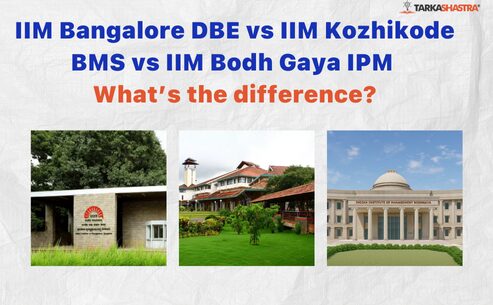The Integrated Program in Management Aptitude Test (IPMAT) is a gateway to prestigious five-year management programs offered by IIM Indore and IIM Rohtak. Every year, thousands of students compete for limited seats, hoping to kickstart their management journey right after Class 12.
But cracking IPMAT isn’t just about knowing the syllabus or solving hundreds of questions—it’s about playing smart. And the most innovative way to begin is by understanding the marking scheme inside-out.
A detailed grasp of marks distribution and negative marking rules helps aspirants:
- Maximize their scoring potential
- Avoid common traps like over-attempting
- Plan time management strategies for each section
In this blog, we will break down the marking scheme of IPMAT 2026 for both IIM Indore and IIM Rohtak, compare their approaches, and give you expert insights into how to tailor your preparation accordingly.
Let’s begin with an overview of the exam format before diving deep into how marks are awarded—and deducted.
Overview of IPMAT 2026
Before we discuss marks and penalties, it’s important to understand how the IPMAT exam structure differs between the two institutes that conduct it—IIM Indore and IIM Rohtak. While both exams aim to assess a student’s aptitude for management education, they do so in distinct formats.
IPMAT 2026 – IIM Indore Pattern at a Glance
| Feature | Details |
| Conducting Body | IIM Indore |
| Exam Mode | Computer-Based Test (CBT) |
| Total Sections | 3 |
| Sections | Quantitative Ability (MCQ), Quantitative Ability (SA), Verbal Ability (MCQ) |
| Total Questions | 90 |
| Duration | 120 minutes |
| Question Type | MCQ + Short Answer (SA) |
| Language | English |
Highlights:
- It includes short answer (SA) type questions, unlike most other entrance tests.
- Time-bound sections with individual timers.
IPMAT 2026 – IIM Rohtak Pattern at a Glance
| Feature | Details |
| Conducting Body | IIM Rohtak |
| Exam Mode | Computer-Based Test (CBT) |
| Total Sections | 3 |
| Sections | Quantitative Ability, Logical Reasoning, Verbal Ability |
| Total Questions | 120 |
| Duration | 120 minutes |
| Question Type | All MCQs |
| Language | English |
Highlights:
- No short-answer questions; all are MCQs.
- Equal weightage is given to all three sections.
- Straightforward structure but a high question count.
In Summary:
While IIM Indore emphasizes conceptual clarity (primarily through its Short Answer section), IIM Rohtak tests both speed and accuracy across broader sections, including Logical Reasoning.
This difference in structure directly affects how marks are distributed—which we’ll explore in the following sections.
Section-Wise Marks Distribution – IIM Indore
The IPMAT 2026 exam conducted by IIM Indore is unique due to its inclusion of Short Answer (SA) type questions, which test students’ core conceptual clarity without the advantage of options.
The paper is divided into three sections, each with a different focus and marking pattern. Let’s take a closer look:
IPMAT Indore 2026 – Marks Distribution
| Section | Number of Questions | Marks per Question | Total Marks | Negative Marking |
| Quantitative Ability (MCQ) | 30 | +4 | 120 | -1 |
| Quantitative Ability (Short Ans) | 15 | +4 | 60 | 0 (No negative) |
| Verbal Ability (MCQ) | 45 | +4 | 180 | -1 |
| Total | 90 | — | 360 | — |
Explanation:
- MCQ Questions: Standard multiple-choice questions with four options. Selecting the wrong answer leads to a negative marking of -1.
- Short Answer Questions (SA): No options are given. You have to type in the correct answer. Here, there is no penalty for wrong answers, making it a strategic scoring area.
- The verbal Ability Section is purely MCQ-based and tends to test grammar, vocabulary, and comprehension.
Key Takeaways for IIM Indore:
- Each correct answer earns +4 marks.
- The short Answer section is a scoring opportunity since there’s no risk of losing marks.
- With 90 questions in 120 minutes, time management is crucial, especially with separate time blocks for each section.
Section-Wise Marks Distribution – IIM Rohtak
The IPMAT 2026 exam conducted by IIM Rohtak follows a more straightforward and balanced structure. It consists entirely of Multiple-Choice Questions (MCQs) spread equally across three sections, making it a test of speed, accuracy, and mental agility.
Let’s break down how marks are distributed:
IPMAT Rohtak 2026 – Marks Distribution
| Section | Number of Questions | Marks per Question | Total Marks | Negative Marking |
| Quantitative Ability | 40 | +4 | 160 | -1 |
| Logical Reasoning | 40 | +4 | 160 | -1 |
| Verbal Ability | 40 | +4 | 160 | -1 |
| Total | 120 | — | 480 | — |
Explanation:
- All sections carry equal weight, with 40 questions each.
- Each correct answer is awarded +4 marks.
- Every wrong answer leads to a penalty of -1 mark.
- All questions are MCQs—no Short Answer (SA) type questions here.
Key Takeaways for IIM Rohtak:
- With 120 questions in 120 minutes, students must average 1 minute per question—making speed and decision-making absolutely essential.
- Since there’s negative marking in all three sections, guesswork can be risky.
- Equal weightage means students must be well-prepared across all three areas, unlike IIM Indore, where Quantitative Ability carries a heavier load.
Negative Marking Rules
Understanding where and how you lose marks is just as important as knowing where you can score. IPMAT 2026 features different negative marking policies for IIM Indore and IIM Rohtak—one of the key strategic differences between the two exams.
Let’s explore each:
Negative Marking in IPMAT Indore
| Section | Question Type | Negative Marking |
| Quantitative Ability (MCQ) | MCQ | -1 per wrong answer |
| Quantitative Ability (Short Ans) | SA | No negative marking |
| Verbal Ability (MCQ) | MCQ | -1 per wrong answer |
Key Points:
- Only MCQ-type questions carry negative markings.
- Short Answer (SA) questions are risk-free—you either gain +4 or score zero. No penalty if your answer is incorrect or left blank.
- This makes the SA section an excellent low-risk, high-reward opportunity if you’ve practised it well.
Negative Marking in IPMAT Rohtak
| Section | Question Type | Negative Marking |
| Quantitative Ability | MCQ | -1 per wrong answer |
| Logical Reasoning | MCQ | -1 per wrong answer |
| Verbal Ability | MCQ | -1 per wrong answer |
Key Points:
- Every section has a uniform negative marking: -1 for every wrong attempt.
- There are no short answer questions, so there’s no “safe zone” like in Indore.
- You need to be cautious with guesses—accuracy trumps speed if unsure.
Summary of Negative Marking Policies
| Feature | IIM Indore | IIM Rohtak |
| Negative Marking for MCQs | Yes (-1) | Yes (-1) |
| Negative Marking for SA Questions | No | Not Applicable |
| Section(s) without Negative Marking | Quant (SA) | None |
| Risk Level | Moderate | High (guessing can be costly) |
Understanding these rules is the first step to building a smart attempt strategy. Next, we’ll compare the two marking schemes side by side.
Key Differences in Marking Schemes: IIM Indore vs IIM Rohtak
Although both IIM Indore and IIM Rohtak use the IPMAT exam to evaluate aspirants for their five-year integrated programs, their marking schemes are fundamentally different. These differences significantly impact how you should approach preparation, time management, and attempt strategy.
Let’s decode the key differences:
Comparison Table – IPMAT 2026: Indore vs Rohtak
| Feature | IIM Indore | IIM Rohtak |
| Total Questions | 90 | 120 |
| Total Marks | 360 | 480 |
| Number of Sections | 3 | 3 |
| Types of Questions | MCQ + Short Answer (SA) | All MCQs |
| Quantitative Ability | MCQ + SA | MCQ only |
| Verbal Ability | MCQ | MCQ |
| Logical Reasoning | (Not tested) | (Included) |
| Negative Marking (MCQ) | Yes (-1) | Yes (-1) |
| Negative Marking (SA) | No Negative Marking | Not Applicable |
| Section Without Negative Marking | Quant (Short Answer) | None |
| Time Limit | 120 mins with sectional timing | 120 mins (flexible time use) |
| Difficulty Level | Conceptual depth-focused | Speed and accuracy-focused |
What These Differences Mean for You
IIM Indore:
- More weightage on Quantitative Ability through dual sections (MCQ + SA)
- Strategic advantage in SA questions with no negative marking
- Focus on conceptual clarity and accuracy under sectional time pressure
IIM Rohtak:
- Equal weight across all three sections
- No section without negative marking—guessing is riskier
- High emphasis on speed, logical thinking, and time allocation
Strategy Implication:
If you’re aiming for both exams, your prep should cover:
- Conceptual depth for Indore, especially Quant
- Speed and balance for Rohtak, especially across Logical Reasoning and Verbal
How to Strategize Based on the Marking Scheme
Knowing the marking scheme is only half the battle—the real win lies in aligning your exam strategy with it. Since IIM Indore and IIM Rohtak differ significantly in question types, weightage, and penalty rules, your preparation and attempt plan should adapt accordingly.
Let’s break down what this means in practice:
Strategy for IIM Indore
- Prioritize the Short Answer (SA) Section:
- No negative marking = Safe scoring zone
- Even if you’re unsure, attempt with calculated logic
- Practice typing speed and accurate numeric inputs
- Be Cautious in MCQ Sections:
- A negative marking of -1 can pull down scores
- If unsure between options, skip rather than guess blindly
- Balance Speed & Accuracy with Sectional Timing:
- Each section is time-bound; you can’t switch midway
- Use mocks to get familiar with time splits and reduce panic
- Maximize Verbal Ability:
- 45 questions out of 90 = 50% weight
- Vocabulary, comprehension and grammar can fetch quick marks with low time investment
Strategy for IIM Rohtak
- One Minute per Question – Use It Wisely:
- With 120 questions in 120 minutes, every second matters
- Practice mental math, fast reading, and quick logic application
- Accuracy > Attempt Rate:
- All sections have negative marking
- Develop the ability to eliminate options and skip wisely
- Equal Sectional Importance:
- No section has extra weight—don’t over-invest in one
- Time your mocks to practice balanced section attempts
- Logical Reasoning Needs Daily Practice:
- This section is unique to Rohtak and can make or break your attempt
- Focus on puzzles, arrangements, series, coding-decoding, etc.
Bonus Tip: Create Two Separate Test Approaches
| IPMAT Indore | IPMAT Rohtak |
| Focus on concepts + accuracy | Focus on speed + balance |
| Attempt more SA, play safe in MCQs | Attempt where 70–80% confident |
| Sectional mocks with timers | Full-length mocks with time tracking |
Smart prep isn’t about solving the most questions—it’s about scoring the most marks. And for that, your marking-scheme-based strategy is your secret weapon.
Mistakes to Avoid in Marking Strategy
Even the most well-prepared aspirants lose out due to avoidable strategic errors in the exam hall. The IPMAT marking scheme, with its negative marking traps and time pressure, can punish overconfidence just as harshly as under-preparation.
Here are the top mistakes you must avoid if you want to convert your preparation into marks:
1. Blind Guessing in MCQs
- Every wrong MCQ answer costs you a -1 mark in both Indore and Rohtak.
- Avoid random attempts—they can tank your overall score.
- Instead, use option elimination techniques and only attempt if you’re 70%+ sure.
2. Ignoring the Short Answer (SA) Section in Indore
- Many students focus only on MCQs and neglect the SA section.
- But SA questions:
- Have no negative marking
- Often come from frequently repeated concepts
- This is a low-risk, high-reward section—don’t leave it underprepared.
3. Poor Time Allocation
- In Indore & Rohtak, sectional time limits mean you can’t shift leftover time from one section to another.
- Your strategy should include mock-based time simulations to strike the right balance.
4. Over-Attempting in a Race Against Time
- In Rohtak, the one-minute-per-question pressure leads some students to attempt all 120 questions.
- But with negative markings in every section, quality beats quantity.
- Even a 90–95 attempt strategy with 85% accuracy can yield better results than attempting all with low precision.
5. Underestimating the Importance of Verbal & Logical Reasoning
- Quantity is not everything.
- In Rohtak, Verbal and LR make up 2/3rd of your paper.
- In Indore, Verbal alone is 45 out of 90 questions.
- These are often easier to score and less time-consuming than Quant.
Pro Tip: Post-mock analysis is more critical than mock-taking.
Understand where you’re losing marks—guessing, rushing, misreading, or spending too much time.
Conclusion
The IPMAT 2026 marking scheme isn’t just a set of numbers—it’s a strategic roadmap for your preparation and performance.
From the risk-free Short Answer section in IIM Indore to the uniform but unforgiving structure of IIM Rohtak, each element of the marking scheme influences how you study, how you attempt, and how you succeed.
Here’s what you should take away:
- Every mark counts—and so does every negative mark.
- Accuracy beats speed when negative marking is involved.
- Understanding the paper’s structure helps you play to your strengths.
At Tarkashastra, we train aspirants not just to solve questions but to understand patterns, avoid traps, and master the exam with precision.
If you’re preparing for IPMAT 2026, don’t go in blind. Go in prepared—with a strategy built on insights like these.
Want expert guidance for your IPMAT 2026 journey?
Join our dedicated IPMAT coaching programs for IIM Indore & IIM Rohtak.
FAQs on IPMAT 2026 Marking Scheme
1. What is the total number of questions in IPMAT 2026 Indore and Rohtak?
IPMAT Indore consists of 90 questions, while IPMAT Rohtak includes 120 questions, covering all key aptitude areas, including Quant, Verbal, and Logical Reasoning.
2. How many marks is each question worth in IPMAT?
In both exams, each question carries +4 marks for a correct answer, making every question equally valuable in terms of scoring potential.
3. Is there a negative marking in IPMAT 2026?
Yes, a -1 mark is deducted for each incorrect MCQ in both the Indore and Rohtak exams. However, IIM Indore SA questions are exempt.
4. Are there any sections without negative markings?
Yes, the Short Answer (SA) section in IIM Indore has no negative marking, offering a great scoring opportunity without the risk of penalty.
5. Does IIM Rohtak have Short Answer (SA) questions?
No, IIM Rohtak has only MCQ-type questions across all sections. There are no Short Answer or typed-response questions in this exam.
6. Is guessing recommended in IPMAT?
Blind guessing is discouraged due to negative marking. Only attempt it if you’re reasonably confident or can safely eliminate 2–3 options.
7. What is the total score of IPMAT 2026 Indore?
The total score for IIM Indore’s paper is 360 marks, derived from 90 questions, each carrying 4 marks.
8. What is the total score of IPMAT 2026 Rohtak?
IIM Rohtak’s IPMAT paper scored out of 480 marks, based on 120 questions with 4 marks each for correct answers.
9. Are all sections equally weighted?
No. IIM Indore has uneven section weights, with Verbal Ability having the most questions. At the same time, IIM Rohtak gives equal weightage to all sections.
10. Is there a sectional time limit for both exams?
Yes, both exams have sectional time limits—you get a fixed time for each section and cannot transfer unused time between them.
11. Can I move between sections during the IPMAT exam?
No, once the sectional timer ends, the following section begins automatically. You cannot revisit or switch between sections freely.
12. How is the Quantitative Ability section structured in IIM Indore?
It’s split into two parts: 30 MCQs (with negative marking) and 15 Short Answer questions (without negative marking), testing conceptual clarity and problem-solving.
13. Which section is best to maximize the score in IIM Indore?
The Short Answer (SA) section offers the best scoring potential because there is no penalty, and questions often cover standard quant concepts.
14. What’s the most significant scoring risk in IIM Rohtak?
Every question carries an equal negative marking, so careless or desperate guessing can cost heavily across all sections—accuracy is critical.
15. Is Logical Reasoning tested in IIM Indore?
No, IIM Indore does not include Logical Reasoning in its IPMAT paper. It is a key component only in the Rohtak version.
16. Should I attempt all questions in IPMAT Rohtak?
Attempting all questions is risky. It’s better to focus on accuracy, as negative markings on all questions can reduce your total score.
17. How is the final score calculated in IPMAT?
The score is calculated as: (Correct Answers × 4) – (Incorrect Answers × 1). Unattempted questions do not affect the total.
18. Is there any weightage given to specific sections in the final selection?
Yes, during final admissions, IIMs may give different weights to sections or interview rounds, which can influence overall selection scores.
19. Are unanswered questions penalized?
No. Leaving a question blank has no impact on your score. It’s a safer option than taking random guesses and losing marks.
20. How important is it to align preparation with the marking scheme?
It’s essential—understanding where to score and where to avoid risks can directly impact your final performance and percentile.







